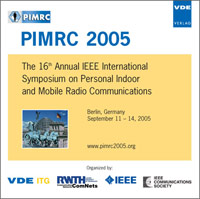Fundamental Simulated Performance of Downlink Fixed Wireless Cellular Networks with Multiple Antennas
Konferenz: PIMRC 2005 - 16th Annual IEEE International Symposium on Personal Indoor and Mobile Radio Communications
11.09.2005 - 14.09.2005 in Berlin, Germany
Tagungsband: PIMRC 2005
Seiten: 5Sprache: EnglischTyp: PDF
Persönliche VDE-Mitglieder erhalten auf diesen Artikel 10% Rabatt
Autoren:
Huang, Howard; Valenzuela, Reinaldo A. (Bell Labs, Lucent Technologies, NJ 07733, USA)
Inhalt:
Multiple antenna techniques for spatial multiplexing (SM) and spatial division multiple access (SDMA) are efficient ways to increase spectral efficiency. We characterize downlink fixed wireless systems using a few essential parameters - including number of antennas per link, number of sectors per cell, and frequency reuse plan - and study their impact on the system spectral efficiency and user peak rates through simulation. Characterizing the system in this way provides insight into the fundamental performance of fixed wireless systems and tradeoffs between SM and SDMA that are independent of specific air interface implementations. We conclude that for a given number of transmit and receive antennas, SM is efficient for increasing user peak rates, but SDMA is more efficient for increasing system spectral efficiency.


